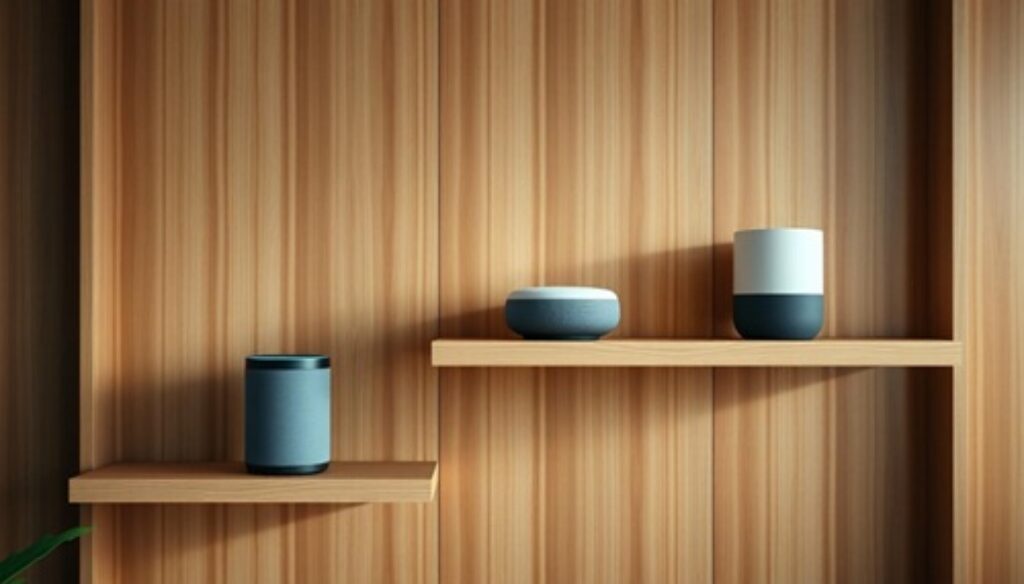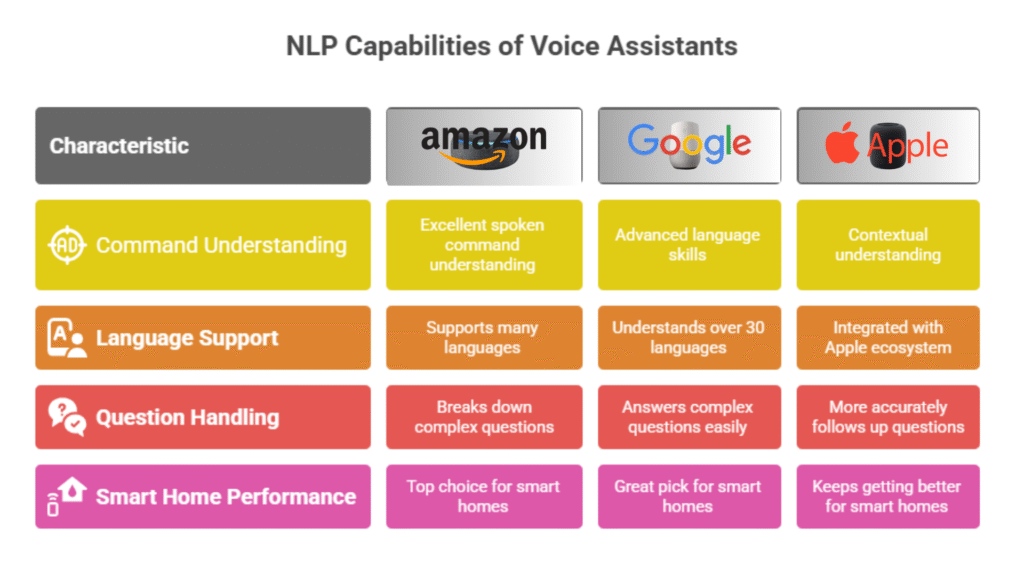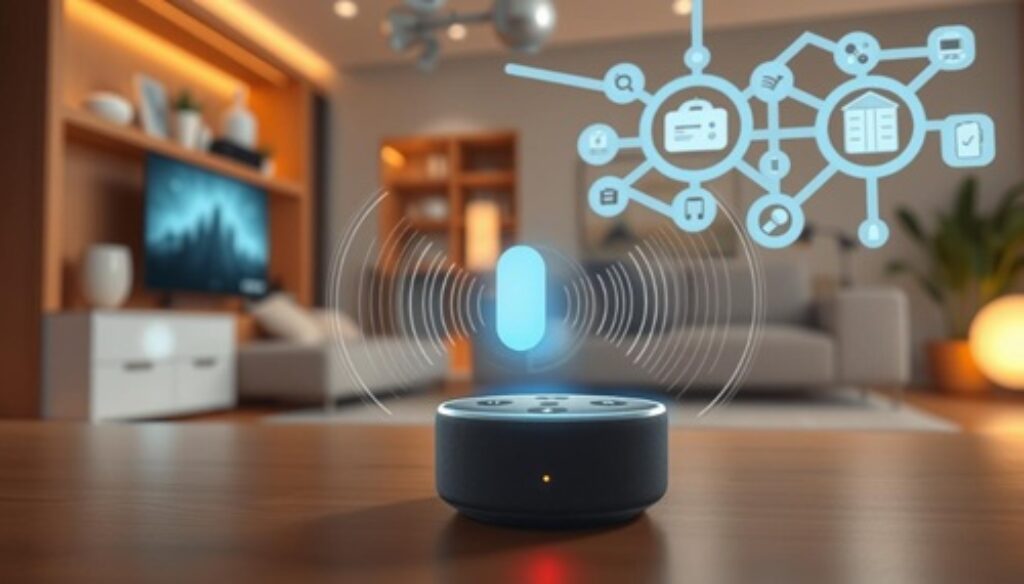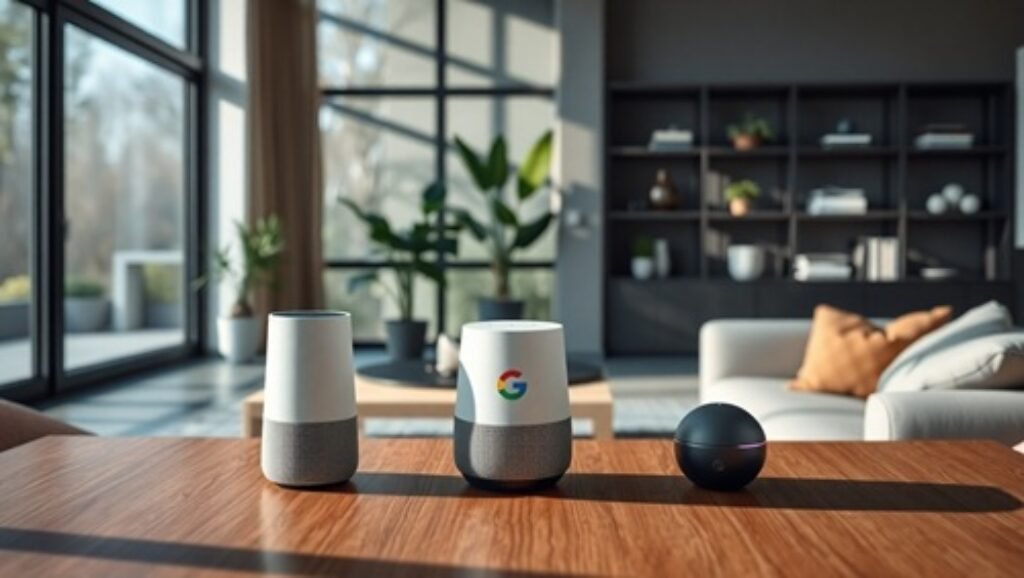Introduction:
Have you ever wondered which voice assistant makes your smart home the smartest? As technology plays a bigger role in our lives, voice assistants like Alexa, Google Home, and Siri are key. But which one is the best?
We’ll compare these three popular voice assistants in detail, examining their natural language skills and how well they work with smart home devices.
Our goal is to find out which one is the most functional and satisfying for your smart home.
Key Takeaways
- Introduction to the defining characteristics of Alexa, Google Home, and Siri.
- Comparison of device compatibility for seamless smart home integration.
- Analysis of natural language processing capabilities among the three voice assistants.
- Evaluation of communication and voice command features.
- Insights into music streaming service integrations and user interface ease.
Introduction to Smart Home Voice Assistant
Smart home voice assistants have changed how we live.
Devices like Amazon’s Alexa, Google Home, and Apple’s Siri make controlling smart devices easy. They bring convenience and efficiency to our daily lives.
At first, these devices could only do simple things. But now, thanks to AI and NLP, they can do a lot more. They can set reminders, play music, and even control your home’s security.
When we compare these assistants, we see they each have their strengths. Alexa works well with many devices, making it a great choice for smart homes.
Google Home is known for understanding language well and giving accurate answers.
Siri, on the other hand, works best with Apple products, offering a smooth experience for iOS users.
Exploring these voice assistants’ abilities is key. Each section will focus on Alexa, Google Home, and Siri. We’ll compare their features to help you choose the best one for your home.
Overview of Alexa, GoogleHome, and Siri
Amazon’s Alexa, Google Home, and Apple’s Siri are the top names in smart speakers. Each has its strengths, drawing in users with unique features.
Amazon Alexa started in 2014 with the Amazon Echo. It’s known for playing music, setting reminders, and managing smart home devices.
Alexa works with thousands of products, making it a top choice for smart home needs.

Google Home came out in 2016, using Google’s vast data and search skills. Google Assistant, its brain, is great at understanding complex commands. It gives detailed answers and controls many smart home devices.
Apple Siri was first on the iPhone in 2011 and later in the HomePod. It’s a hit with Apple fans for its easy integration with Apple products. Siri might not work with as many devices as others, but it’s strong on privacy and security.
Recent surveys show Amazon Alexa is the most popular, followed by Google Home. Siri, though not as big in the smart speaker world, has a dedicated Apple fan base. This shows how user preferences are changing.
Voice Assistant Compatibility with Smart Home Devices
Choosing between Alexa, Google Home, and Siri depends on smart home device compatibility.
Each voice assistant has its strengths and weaknesses.
This section will look at how well these voice-activated home devices work with different smart home products.
Alexa’s voice assistant Device Compatibility
Alexa, powered by Amazon, works well with many smart home devices. It can control over 85,000 smart home products. This makes it a top choice for setting up a smart home.
Google Assistant’s Device Compatibility
Google Assistant is very compatible, too. It works with thousands of devices from brands like Philips Hue and Nest. It’s easy to use and offers smart home automation suggestions.
Siri’s voice assistant Device Compatibility
Apple’s Siri works with the HomeKit ecosystem for a secure smart home. It may not work with as many devices as Alexa and Google Assistant. But it’s reliable and secure, making it a good choice for many.
Natural Language Processing Capabilities
Voice assistants have made huge leaps forward, thanks to natural language processing (NLP).
This section looks at how Alexa, Google Assistant, and Siri handle user commands and complex questions. It also explores their ability to keep up with conversations in smart homes.
Alexa’s Understanding of Commands
Alexa, powered by Amazon’s advanced language processing, is great at understanding spoken commands.
It works with many languages and can even get what you say in noisy places.
Alexa breaks down tough questions into simpler tasks, making it a top choice for smart homes.
Google Assistant’s Sophisticated Language Processing
Google Assistant is known for its advanced language skills. It uses Google’s search technology to answer complex questions easily. With its ability to understand over 30languages, it’s a great pick for smart homes.
Siri’s Contextual Understanding
Apple’s Siri is known for its ability to understand the context of conversations. It can follow up on questions more accurately, making interactions smoother. Siri’s integration with Apple’s ecosystem means it keeps getting better for smart homes.

Voice Assistants in Smart Homes: Comparing Alexa, Google Home, and Siri
When we look at voice assistants in smart homes, we need to consider how well they work, how easy they are to use, and how well they connect with other devices.
Alexa, Google Home, and Siri each have special features that meet different needs.
This part will explore these features to give a fair voice assistants comparison.
Alexa is great at home automation and works well with many devices. It’s perfect for those who want a smart home. Its easy commands and lots of third-party skills make it very popular.
Google Home, powered by Google Assistant, is known for its natural language processing. This means it can understand and respond to conversations more smoothly. It also works well with Google services, which is great for Google users.
Siri, part of Apple’s system, works well for Apple users. It understands the context and focuses on privacy.
This makes it a good choice for those who value their data and use Apple devices.
In our voice assistants comparison, each one has its own strengths. Alexa is best for those who want lots of device support.
Google Home is great for Google users who want a smart assistant that integrates well with their services.
Siri is perfect for Apple fans who care about security and seamless integration.
Device Ecosystem Comparison
Interactive map of voice assistant compatibility
Communication and Voice Command Features
Alexa, Google Assistant, and Siri make daily tasks easier. They let you call, text, and control other devices with your voice. This makes life simpler and more convenient.
Alexa’s Communication Features
Alexa from Amazon is known for its great communication tools. You can call, text, and even talk to other Echo devices hands-free.
The drop-in feature is perfect for big homes, letting you talk to anyone with an Alexa device.
Alexa can also send messages to all Echo devices. This makes sharing news or reminders easy for everyone at home.
Google Assistant’s Communication Features

Google Assistant is great for talking and messaging. You can call and text others, or use messaging apps. It’s also good at sending messages to all Google Home speakers at once.
Google Assistant works well with devices like the Nest Hub. This makes video calls easy and convenient.
Siri’s Communication Features
Siri from Apple offers many ways to communicate. You can make calls, send texts, and use iMessage with your voice. Siri works well with Apple devices, making it easy to switch calls from HomePod to iPhone.
Siri’s Intercom feature lets you send messages to all HomePods. This keeps everyone in the loop without any hassle.
Voice Assistant Integration with Music Streaming Services
Enjoying your favorite tunes is easier with voice assistants. Alexa, Google Assistant, and Siri make it seamless. They work well with many music services.
Alexa’s Music Integration
Alexa supports Amazon Music, Spotify, Apple Music, and Pandora. You can play, pause, and skip tracks with voice commands. It’s great for playing music in different rooms.
Just say, “Alexa, play jazz in the living room,” and enjoy the music.
Google Assistant’s Music Integration
Google Assistant works with YouTube Music, Spotify, Apple Music, and Deezer.
It understands your requests well, like “Hey Google, play my morning playlist.” It also works with Google Home and Nest devices.
Siri’s Music Integration
Siri is perfect for Apple Music users. You can access your music library with just your voice. Say “Hey Siri, play my workout playlist” to start playing.
Siri also supports Spotify and other services. It’s great for those in the Apple ecosystem.
Voice Assistant Answering Queries and Providing Information
In the world of answering queries with Alexa, Google Home, and Siri, each smart assistant has its own way of responding.
They differ in how they find and share information. It’s key to look at how well they can find and share reliable information quickly.

Alexa, from Amazon, is great at quickly finding answers. It’s very good at answering simple questions, showing it’s accurate and fast.
Google Home, powered by Google, is all about giving detailed answers. It’s good at handling complex questions. Its connection to Google Search makes it even better at finding info.
Siri, from Apple, is easy to use, mainly for Apple users. While it answers questions well, it might not give as much info as Alexa or Google Home.
Still, it works well with Apple devices and understands the context of your questions.
Voice Assistant User Interface and Ease of Setup
Looking into the design of user interfaces and setup for smart speakers is key.
It’s important for those adding voice assistants to their homes. The ease and simplicity of use greatly improve the experience.
We’ll explore how to set up Alexa, Google Assistant, and Siri, highlighting their user-friendly features.
Setting Up the Alexa voice assistant
Amazon Alexa has a simple setup for smart speakers, making it incredibly accessible. To start, plug in the device, download the Amazon Alexa app, and follow the app’s instructions.
The app facilitates network connections, language selection, and device linking, ensuring a smooth experience.
Setting Up Google Assistant
Google Assistant’s setup is easy, too. First, install the Google Home app and follow the steps.
The app’s design is intuitive, helping newcomers to smart tech. Getting up and running involves linking Google accounts, connecting to Wi-Fi, and setting preferences.
Setting Up Siri Voice Assistant
Setting up Apple’s Siri on HomePod is straightforward. Just power on the HomePod, place your iPhone nearby, and follow the prompt.
This includes connecting to Wi-Fi, syncing with Apple Music, and setting up HomeKit devices.
Siri offers a hands-free setup that works well with Apple products.
Conclusion
Choosing the best voice assistant for home automation depends on your needs and current setup. Our comparison of Alexa, Google Home, and Siri shows each has its strengths.
They cater to different user preferences, whether it’s device compatibility, natural language, or music integration.
Alexa is great for those in the Amazon ecosystem, thanks to its wide device support and communication features.
Google Assistant is best for those who need advanced search and natural language processing.
Siri is perfect for Apple fans who value privacy and understanding their context.
In the end, pick a voice assistant that fits your ecosystem and needs. Consider what’s important to you, like detailed answers or easy setup.
Final Thoughts
Each assistant offers unique benefits, helping you choose the best for your smart home.
Discover the ultimate Smart Home Device Support Directory—featuring direct links to official help centers, developer docs, and active community forums for top ecosystems, manufacturers, and smart protocols.
FAQ
What are the primary voice assistants used in smart homes?
The main voice assistants in smart homes are Amazon Alexa, Google Assistant (Google Home), and Apple’s Siri.
How do Alexa, Google Home, and Siri compare in terms of device compatibility?
Alexa works well with many smart devices. Google Assistant is also compatible, but shines with Google products. Siri is best with Apple’s HomeKit devices.
Which voice assistant has the best natural language processing capabilities?
Google Assistant is known for its advanced language skills. It understands complex commands better than Alexa and Siri.
What are the communication features available with Alexa, Google Assistant, and Siri?
Alexa has features like Drop-In and Announcements. Google Assistant offers Broadcast and Family Bell. Siri integrates well with iMessage and FaceTime.
Can these voice assistants integrate with music streaming services, and if so, which ones?
Yes, they can all connect with music services. Alexa works with Amazon Music, Spotify, Apple Music, and more. Google Assistant integrates with YouTube Music, Spotify, and Apple Music. Siri mainly supports Apple Music but also Spotify.
How effective are these voice assistants in answering queries and providing information?
Google Assistant is great at answering questions thanks to Google Search. Alexa and Siri are good, but not as quick or thorough as Google Assistant.
What is involved in setting up each voice assistant for smart home use?
Setting up Alexa means using the Alexa app to connect to devices and Wi-Fi. Google Assistant setup is through the Google Home app, linking with Google services. Siri setup requires the Apple Home app and an Apple ID.


